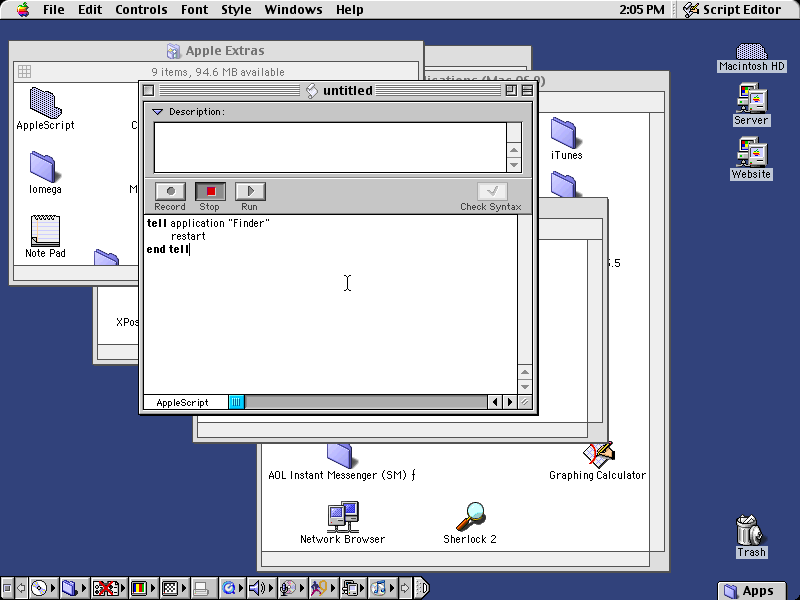What is Classic environment , with OSX 10.6.8?
Posted by: BigH47 on 28 February 2012
Looking at some extra stuff on a CD I clicked on the file and got a "sorry Classic environment is no longer supported".
I assume this is something lost with an OSX update?
Is there anyway of still exploring these CDs?
Most likely Classic is referring to Mac OS 9 and earlier. I believe you could run it on 10.5 (or is it 10.4) and earlier systems if you had an original OS 9 installer CD.
OS 9 went out of production and was replaced by OS X over a decade ago.
As for answering your question about whether the CD can be browsed, you haven't really provided enough details about what it is.
It's a CDR of Aimee Mann - Bachelor No2 when inserted 2 CD icons come up on the screen. I was assuming one was the music and the other was the interactive or web accessible stuff.
1 CD icon called the album title has the AIFF files, the other CD icon has files Extras, PC, Quick time and a square one with an unknown to me icon in it, it's that icon that when clicked brings up the error.
Are you positive it's a Mac-supported title and not a Windows one? The PC folder is my clue it's for Windows. The error you get could be bogus.
Does the file have an extension on it (you might need to select it and do a Get Info if the extension is hidden).

The classic Mac OS 9 and what a great system.
In the good old days before the turn of the next century the Mac used to run on Motorola chips. They had great names - there was the G3 and G4 and G5. Apple built an operating system that ran on this chip called OS 9 and it brought with it a new application called iTunes.
OS 9 was great. It was co-operative multi-tasking rather than pre-emptive just like Windows at the time. The Amiga from 1986 was fully pre-emptive so a much better design all round (but the Amiga OS was British so it never caught on - owing to the Commodore's attitude to customers). What that means is that on Mac OS 9 the application programmer could decide what computer resources he or she wanted to hog use; though nice programmers used to share resources. if two programs hogged the same resource you got a conflict and it locked up. So there was a program called Conflict Catcher that used run all your programs and work out which ones didn't get on together and sort it all out for you.
With the Amiga, Unix and OSX and Windows NT/2000 everybody went pre-emptive and the operating system prevented conflicts. Poor old Aladdin software suffered 'cos nobody wanted a conflict catcher any longer.
In May 2002, at Apple's Worldwide Developers Conference, Steve Jobs, accompanied by a coffin, held a mock funeral to announce that Apple had stopped development of Mac OS 9.
When OS X came out, which was a version of Steve Jobs, NeXt OS based on Darwin Unix (itself a derivative of a Honeywell kernel), Apple encouraged everybody to rewrite their applications for it. OS X was not backwards compatible and OS 9 applications which some had invested £1000s in would not run. You could reboot easily enough though.
So Apple kindly brought in Classic (originally called Rosetta after the stone, not the Alan Price track). You didn't need to reboot to run your old OS 9 and your applications like Quark Express that were slow to get released on OS X. You could run OS 9 in an OS X window. Classic relied on the Motorola processor.
Then Motorola stopped making processors and the mighty IBM came on the scene to supply Apple (once its sworn enemy) with PowerPC chips - the very same G4/G5. But IBM pulled out and left poor Apple dry and high. Then Steve J had an idea - the rubbish Intel chips were overnight transformed in to the wonderful start of the art Intel chips. It was sewage in to wine - another miracle.
Alas, the Intel chips had a different architecture to the PowerPC and whilst Apple quickly ported OS X to them, it did not support OS 9 on Intel. So in June 2005 Classic vanished. Subsequently, the wonderful PowerPC became the not so wonderful PowerPC and folks who had bought dual PowerPC G5 servers could not upgrade past Leopard (I'm not bitter). So Snow Leopard came and Classic went in to oblivion (it may have already been phased out).
If you have old media then it is just possible it is an OS 9 application and sorry but you can no more run that than you could a Sinclair QL program for which you need a Merlin Tonto (remember those: oh how we loved our Microdrives on our One Per Desk).

But back on thread and of more relevance, OS 9 programs didn't use file extensions (which were an invention of the devil at the Gates of hell). It used file descriptors so OS9 knew what application created the file. So you may find Quicktime will open the file if you give it a suitable file extension.
So from Sonata in 1999 through to Limelight LU1 in December 2001, OS 9 was Apple's OS.
So life goes ever on and I say bring back HYPERCARD - Apple's finest moment.
Thanks Guido , interesting but I didn't understand a word of that.
Thanks Guido , interesting but I didn't understand a word of that.
No need to. It is mostly irrelevant to your problem, so there's nothing there to understand, unless one wants to reminisce.
Guy,
I'm with you on this one.
Jono
(note to self: dig out original bondi blue iMac from garage and fire it up this weekend)
